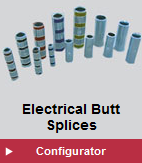A Splice Connector is an electric connector which allows for two cables or wire leads to connect within the body of the splice. These splices are crimped or soldered such that the power conducted from the source cable to the next cable is transferred at an acceptable conductivity and pull-out resistance performance level. The Glossary of Terms provides additional information.
Utilities use Splice Connectors for multiple applications, splicing underground or overhead cable, splicing power generation cables to substation connections, or splicing transformers to power source or use cables. Splice Connectors can also be used to join both very small gauge (36 Gauge to 12 Gauge) wire or large cable ( 8 Gauge to 1000MCM).
These applications may be addressed with different Connector Splice types:
Service Entrance Splices: Aluminum or Copper tubular splices, with "Center Stop", which can be either "insulated" or "insulated", range in size from 6 Gauge to 250 MCM, and are generally used in connecting residential or commercial users to the pole-mounted transformers.
Partial Tension Splices: Aluminum or Copper tubular splices, with "Center Stop", range in size from 6 Gauge to 1050 MCM, and are generally used in underground or substation applications. "Partial Tension" implies that when spliced, the splice will hold pull-out tensile strength to within 90% of RBS (Rated Breaking Strength) of the cable spliced. Generally, this rules out use in overhead applications where long spans of cable are involved.
Full Tension Slices: Aluminum or Copper tubular splices, with "Center Stop", range in size from 6 Gauge to 1050 MCM, and are generally used in underground or substation applications. "Partial Tension" implies that when spliced, the splice will hold pull-out tensile strength to within 95% of RBS (Rated Breaking Strength) of the cable spliced. Generally, Full Tension connectors are for use in overhead applications where long spans of cable are involved.
Butt Splice Connectors: Copper tubular splices, withOUT "Center Stop", range in size from 6 Gauge to 4/0, often used in battery and battery backup and telecom applications. The cables are "butted up" against eachother during splicing.
Parallel Splice Connectors: Copper tubular splices, withOUT "Center Stop", range in size from 6 Gauge to 4/0, often used in battery and battery backup and telecom applications. The cables overlap inside the splice during splicing to ensure pull-out resistance performance.
Pin Splice Connectors: Copper or Aluminum cable barrels and copper clamp rods are used to create a splice which "crimps" on to cable and allows for field clamping. Pins are used for residential and commercial power pole locations as well as substation applications. They generally utilize a Center Stop, to combat bi-metallic corrosion between aluminum and copper. Cable sizes addressed are between 2 gauge and 350 MCM, with clamping bar diameters of between 3/8 and 1/2" and between 2 and 10 inches in length.
Generally, all splices which are crimped, are specified for use with specific cable sizes and construction, with specific "crimp die" inserts appropriate for the connector and cable used.
Our Utility Catalog Table of Contents identifies the Types of Splices and ranges of sizes and crimp die information necessary to select our product.
ASK Products has been manufacturing Electrical Connectors for over 50 years. Trusted and listed on Investor-Owned -Utility Standards Lists, they perform to the highest conductivity and pull-out resistance standards of ANSI C119 and UL 486 A and UL 486 B. ASK is a 100% AMERICAN Manufacturer.



 1674 Frontenac Rd | Naperville, IL 60563
1674 Frontenac Rd | Naperville, IL 60563